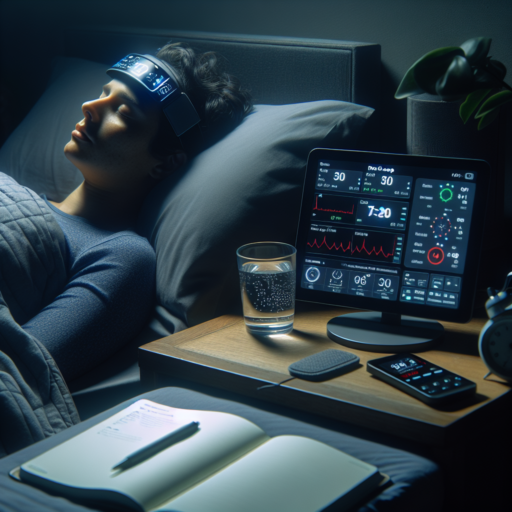Understanding the Fundamentals of REM Sleep
REM sleep, or Rapid Eye Movement sleep, is a critical component of our sleep cycle that occurs periodically throughout the night. It’s distinguished from other sleep stages by its characteristic fast, darting movements of the eyes. Understanding the nuances of REM sleep can provide insightful revelations about our sleep patterns and overall health.
Diving into the fundamentals, the REM phase is most notably associated with vivid dreaming. During this stage, the brain’s activity mirrors that of being awake, making dreams intensely vivid and often remembered upon waking. This unique characteristic of REM sleep indicates its crucial role in emotional regulation and memory consolidation, further highlighting its importance in our cognitive functioning and mental health.
Moreover, REM sleep duration and quality can significantly influence our daily performance. The lack of sufficient REM sleep is often linked to increased risk of chronic illnesses, impaired cognitive function, and a weakened immune system. These factors underscore the necessity of prioritizing REM sleep within our nightly sleep routines.
Why Tracking REM Sleep Is Essential For Your Health
Understanding and tracking REM sleep, or Rapid Eye Movement sleep, is crucial for maintaining optimal health. During REM sleep, your brain activity increases, leading to vivid dreams. This phase is essential for emotional regulation and memory consolidation, impacting how you store memories and manage emotions. Tracking REM sleep can help ensure you are getting enough of this restorative sleep stage.
Experts argue that inadequate REM sleep can lead to a host of health issues, including impaired cognitive function, increased stress responses, and even a weakened immune system. By monitoring your REM sleep patterns, you can identify any irregularities or deficiencies and take steps to address them. This proactive approach can help protect your mental health, enhance learning and memory capabilities, and improve overall emotional stability.
Furthermore, tracking REM sleep is a valuable tool in identifying sleep disorders such as narcolepsy and sleep apnea, which can severely impact your quality of life. Early detection and management of these conditions can prevent further complications and improve sleep quality. Therefore, paying attention to your REM sleep duration and quality is not only beneficial but essential for maintaining good health and well-being.
The Best Tools and Devices to Monitor REM Sleep in 2023
In the pursuit of optimal well-being, understanding and monitoring the quality of our sleep, especially REM (Rapid Eye Movement) sleep, has taken on paramount importance. With advancements in technology, the year 2023 has seen a surge in innovative tools and devices designed to offer deeper insights into our nocturnal patterns. These gizmos not only track the duration of REM sleep but also help in improving overall sleep quality by providing personalized recommendations.
Wearable Sleep Trackers have become increasingly sophisticated, offering features that go beyond mere sleep duration calculations. Leading the pack are devices equipped with heart rate monitoring and accelerometer sensors that meticulously analyze sleep stages, including REM sleep. Notable models include the Fitbit Charge 4 and the Garmin Vivosmart 4, both of which offer detailed sleep reports directly on your smartphone, making them indispensable for anyone looking to optimize their REM cycles.
Another significant breakthrough in REM sleep monitoring is the emergence of Smart Beds and Mattress Pads. These innovative products, such as the Eight Sleep Pod and the Withings Sleep Tracking Mat, incorporate biometric sensors that measure not just sleep cycles but also room temperature and body heat, adjusting themselves to improve sleep quality. The precision and convenience of these devices represent a leap forward in sleep technology, providing insights and adjustments that were once unimaginable.
How to Interpret Your REM Sleep Data for Better Sleep Quality
Understanding your REM sleep data is pivotal in enhancing overall sleep quality. REM, or Rapid Eye Movement sleep, is a critical sleep phase characterized by intense brain activity, where dreams mainly occur. Interpreting this specific data can provide insights into your sleep health and help identify areas for improvement. Traditionally, REM sleep should constitute 20-25% of your total sleep. A deviation from this range could signify potential issues or areas for optimization.
Identify Your REM Sleep Cycle Length
The first step in interpreting your REM sleep data is to examine the length and consistency of your REM cycles. A typical REM cycle lasts about 90 minutes, recurring roughly four to six times throughout the night. Consistent, uninterrupted REM cycles are indicative of restorative, high-quality sleep. Utilizing sleep tracking technology can help pinpoint your cycles’ duration and regularity, highlighting any variations that could be affecting your sleep quality.
Analyze REM Sleep Disruptions
While analyzing your REM sleep data, pay close attention to REM sleep disruptions. Factors such as stress, dietary habits, and even the consumption of alcohol can lead to fragmented REM sleep. Significant gaps or irregularities in your REM pattern could also be indicators of sleep disorders like sleep apnea. Anomalies in REM sleep not only affect sleep quality but can have profound impacts on your overall health, including cognitive functions and emotional well-being.
Step-by-Step Guide: How to Track Your REM Sleep Accurately
Tracking REM sleep is crucial for understanding your sleep quality and overall health. REM, or Rapid Eye Movement sleep, is a stage of sleep associated with dreaming, memory consolidation, and emotional regulation. Accurately tracking this phase can provide insights into your sleep patterns, helping you make informed decisions about your sleep hygiene. This guide outlines a practical approach to monitor your REM sleep effectively.
Choosing the Right Tools for REM Sleep Tracking
Begin by selecting the appropriate technology to monitor your REM stages. Wearable devices like smartwatches and fitness trackers have advanced sensors to detect sleep stages, including REM. Ensure the device you choose is known for its accuracy in sleep tracking. Apps that use sound and movement detection can also provide a supplementary overview of your sleep cycles, though they might not be as precise for REM detection.
Establishing a Consistent Sleep Schedule
Maintaining a regular sleep schedule enhances the ability of these devices to track your sleep patterns effectively. Go to bed and wake up at the same time every day. Consistency reinforces your body’s sleep-wake cycle, making it easier to enter and track REM sleep. Note that irregular sleeping patterns can disrupt REM sleep, making it more challenging to monitor accurately.
- Wear your sleep tracking device every night to ensure a consistent data set.
- Avoid caffeine and electronics before bedtime to reduce interference with your sleep cycle.
- Review your sleep data regularly to identify patterns or concerns in your REM sleep.
No se han encontrado productos.
Improving Your REM Sleep: Tips and Strategies
Enhancing your REM sleep is crucial for improving overall sleep quality and ensuring your mind and body function optimally. Rapid Eye Movement (REM) sleep is a vital sleep stage during which your brain processes emotions, memories, and information from the day. Achieving enough REM sleep can be transformative for your mental and physical health. Here, we explore effective strategies to augment your REM sleep duration and quality.
Creating a Sleep-Friendly Environment
One of the most straightforward steps you can take to boost your REM sleep is to optimize your sleeping environment. Ensure your bedroom is cool, dark, and quiet. Investing in a comfortable mattress and pillows can also make a significant difference. Furthermore, minimizing exposure to blue light from screens at least an hour before bedtime can help maintain your body’s natural sleep-wake cycle, encouraging better REM sleep.
Establishing a Consistent Sleep Schedule
Maintaining a regular sleep schedule is another key factor in promoting REM sleep. Try to go to bed and wake up at the same time every day, even on weekends. This consistency reinforces your body’s sleep-wake cycle, making it easier to fall asleep and enter REM sleep. Additionally, incorporating a relaxing pre-sleep routine such as reading or meditating can prepare your mind and body for sleep, facilitating the transition into REM sleep.
Improving your REM sleep is not an overnight task but incorporating these tips and strategies into your daily routine can significantly improve your sleep quality over time. Understanding the importance of REM sleep and making conscious efforts to enhance it are key steps in achieving restorative sleep and improving overall well-being.
Common Misconceptions About REM Sleep Tracking
Many people have misconceptions about REM (Rapid Eye Movement) sleep tracking, leading to confusion about its purpose and effectiveness. One of the primary misunderstandings is that individuals believe they can accurately track and analyze REM sleep with any fitness tracker or smartwatch. However, the truth is that not all devices offer the same level of precision. REM sleep, being a critical phase for cognitive functions and emotional health, requires sophisticated algorithms and sensors to be monitored accurately.
Another common myth is the assumption that more REM sleep always equates to better quality sleep. It is essential to understand that each sleep stage, including REM, plays a unique role in our overall sleep health. An imbalance in these stages can lead to sleep disorders and impact our wellbeing. Therefore, focusing solely on increasing REM sleep without considering the complete sleep cycle can be misleading.
Additionally, there is a misconception that immediate lifestyle changes can significantly boost one’s REM sleep duration. While habits like reducing caffeine intake and maintaining a consistent sleep schedule can help, they do not guarantee a substantial increase in REM sleep. It’s crucial to approach sleep improvement with realistic expectations and understand that factors like genetics also play a significant role in determining our sleep patterns.
The Impact of Lifestyle Choices on REM Sleep Duration and Quality
The role of lifestyle choices on REM sleep duration and quality cannot be understated, given REM’s essential function in emotional regulation, memory, and learning. Variations in daily habits directly influence the amount and quality of REM sleep an individual can attain, thus affecting overall health and cognitive performance. Understanding these effects can guide us towards better sleep hygiene and, consequently, improved well-being.
Diet and Nutrition
Nutritional intake has a profound influence on REM sleep patterns. For instance, high caffeine and alcohol consumption have been directly linked to reduced REM sleep duration. On the other hand, diets rich in magnesium, vitamin D, and omega-3 fatty acids can promote better REM sleep quality. It’s clear that what we consume before bedtime can either be conducive to achieving restorative REM sleep or detrimental to it.
Physical Activity Levels
Regular physical activity is associated with longer and more consistent REM sleep cycles. Exercise acts as a regulator for sleep patterns, enhancing the body’s ability to transition through all sleep stages, including REM. However, the timing of exercise plays a crucial role; engaging in vigorous exercise close to bedtime may lead to difficulties initiating REM sleep. Thus, maintaining a balanced exercise routine that aligns with our circadian rhythms is key to optimizing REM sleep.
By carefully considering our lifestyle choices, such as diet and exercise, we can significantly impact the duration and quality of our REM sleep. While these factors are within our control, it’s essential to recognize that creating a conducive sleep environment and maintaining a regular sleep schedule are equally important in fostering healthy REM sleep patterns.



